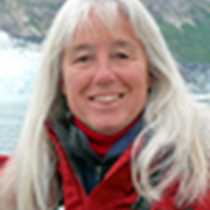Fox Creek, Idaho Inlet, Chichagof Island/Inian Islands/Icy Strait
It was another “Fairweather” day this morning as we cruised from our anchorage near Lemesurier Island toward Idaho Inlet. We anchored at Fox Creek on Chichagof Island for hiking, kayaking and hunting for creatures along the shore.
The beachcombers found many fascinating critters – sea stars, gunnels, sculpins, barnacles, worms, crabs and mussels among them. These specially adapted organisms are able to cling to the substrate or hide under rocks and withstand periods of time without water as the tide ebbs and flows.
Walks went past a worn trail of tracks where bears habitually stepped when walking between forest and meadow. Trees showed claw marks where bears had scratched and had left hairs stuck to the oozing sap. It gave us the feeling that we were having a real Alaska experience, but that we were mere visitors in this wild place.
Kayakers circumnavigated Shaw Island and observed harbor seals, kelp and intertidal organisms. Later in the morning, the wind kicked up and the fog crept over the mountains, giving the area, and the day, a completely different character. When everyone was back on board, we pulled the anchor and encountered some sea otters shortly afterwards. Close passes by these charismatic animals revealed their fastidious grooming habits. It is essential that they keep their fur clean and filled with air to maintain the barrier between their inner core and the surrounding cold water. We are lucky to have the opportunity to observe these marine mammals in the wild, as they were once overexploited for their luxurious pelts. Now they are protected but subsistence hunting is permitted in some areas.
In spite of the wind, we took a detour toward the west and cruised the narrow channels among the Inian Islands – a small archipelago between Icy Strait and Cross Sound. Bird life was abundant and there was a colony of Steller sea lions on one of the islets.
In the late afternoon, fireside stories and poems were told in the lounge by Jeff Rennicke, the National Geographic lecturer. Several of the tales were eagerly acted out by some of the children and included the Ten-legged Polar Bear, How Raven Recaptured the Sun, How Mosquitoes Came To Be and the Cremation of Sam McGee.
Near Point Adolphus this afternoon we were fortunate to see killer whales for the second time this trip. What was really remarkable and exciting, was that we saw them in the proximity of humpback whales. The humpbacks were very active and we wondered what kind of interaction we would witness between the two species. There were no major confrontations and after giving us some close looks, the killer whales went on their way and we continued on ours, further fulfilled and awed by the constant surprises that the natural world provides for us.
It was another “Fairweather” day this morning as we cruised from our anchorage near Lemesurier Island toward Idaho Inlet. We anchored at Fox Creek on Chichagof Island for hiking, kayaking and hunting for creatures along the shore.
The beachcombers found many fascinating critters – sea stars, gunnels, sculpins, barnacles, worms, crabs and mussels among them. These specially adapted organisms are able to cling to the substrate or hide under rocks and withstand periods of time without water as the tide ebbs and flows.
Walks went past a worn trail of tracks where bears habitually stepped when walking between forest and meadow. Trees showed claw marks where bears had scratched and had left hairs stuck to the oozing sap. It gave us the feeling that we were having a real Alaska experience, but that we were mere visitors in this wild place.
Kayakers circumnavigated Shaw Island and observed harbor seals, kelp and intertidal organisms. Later in the morning, the wind kicked up and the fog crept over the mountains, giving the area, and the day, a completely different character. When everyone was back on board, we pulled the anchor and encountered some sea otters shortly afterwards. Close passes by these charismatic animals revealed their fastidious grooming habits. It is essential that they keep their fur clean and filled with air to maintain the barrier between their inner core and the surrounding cold water. We are lucky to have the opportunity to observe these marine mammals in the wild, as they were once overexploited for their luxurious pelts. Now they are protected but subsistence hunting is permitted in some areas.
In spite of the wind, we took a detour toward the west and cruised the narrow channels among the Inian Islands – a small archipelago between Icy Strait and Cross Sound. Bird life was abundant and there was a colony of Steller sea lions on one of the islets.
In the late afternoon, fireside stories and poems were told in the lounge by Jeff Rennicke, the National Geographic lecturer. Several of the tales were eagerly acted out by some of the children and included the Ten-legged Polar Bear, How Raven Recaptured the Sun, How Mosquitoes Came To Be and the Cremation of Sam McGee.
Near Point Adolphus this afternoon we were fortunate to see killer whales for the second time this trip. What was really remarkable and exciting, was that we saw them in the proximity of humpback whales. The humpbacks were very active and we wondered what kind of interaction we would witness between the two species. There were no major confrontations and after giving us some close looks, the killer whales went on their way and we continued on ours, further fulfilled and awed by the constant surprises that the natural world provides for us.




